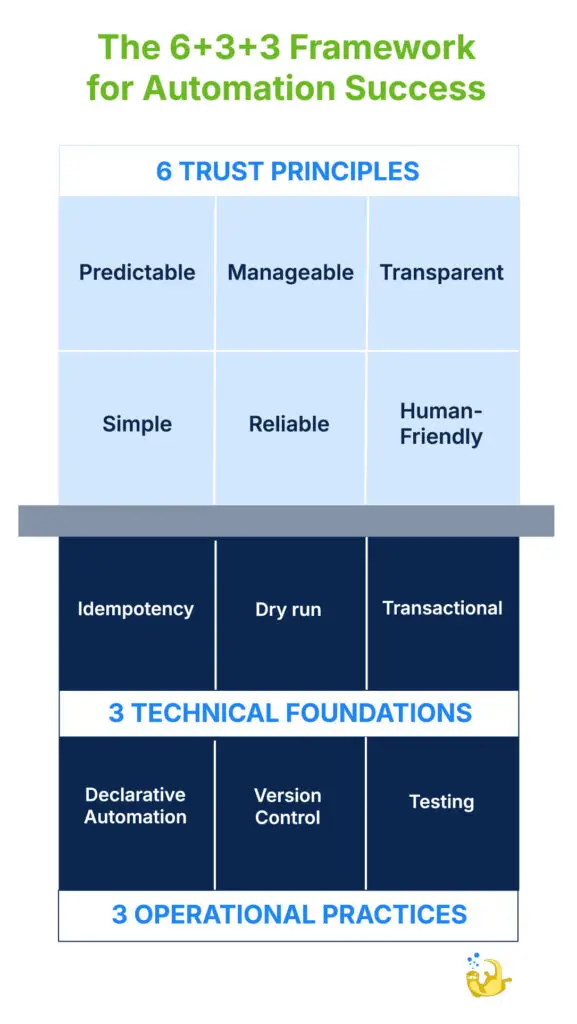Explore the 6 principles, 3 technical foundations, and 3 operational practices that help teams build trustworthy automation at scale.
Trust isn’t automatic—even in automation. Many infrastructure automation initiatives struggle because people don’t trust the tools they’re asked to use. Without trust, automation adoption falters.
Successful automation depends not just on what the system does but on whether people believe it will behave as expected. When you design with trust in mind, you enable better outcomes, smoother adoption, and greater long-term success.
What makes infrastructure automation trustworthy?
Based on learnings from years of building and using automation systems, we’ve found that six core principles, supported by three technical foundations and three operational practices, create a practical framework for building trust into any infrastructure automation effort.
These three layers work together. The six principles define what trust looks like to users. The technical foundations make those principles possible by design. And the operational practices ensure those principles hold up in real-world systems as they grow and evolve.
Why building trust in automation needs a framework
You can have a technically correct automation system that nobody wants to use because it’s opaque, fragile, or unpredictable.
Conversely, infrastructure automation that’s predictable, transparent, and user-friendly inspires confidence and sees far greater adoption.
The 6+3+3 framework gives teams a shared language for evaluating and designing automation systems:
- 6 principles that define the user experience of a trustworthy system
- 3 technical foundations that support those principles by design
- 3 operational practices that make trust scalable
Whether you’re an automation builder or an automation user, applying the 6+3+3 perspective helps you choose, evaluate, and use automation tools more clearly.

The 6 principles of trustworthy automation
1. Predictable
Automation should produce consistent, repeatable outcomes. When you trigger a workflow, you should know what to expect every time—no surprises.
2. Manageable
Workflows and systems must be easy to configure, control, and update. Hidden complexity undermines confidence. Clear interfaces and straightforward management are key.
3. Transparent
Automation should clearly show what it will do and what it has done. Users need visibility into both intent and action. A "black box" creates fear; transparency builds trust.
For example, a system that offers a Preview Changes feature before execution instantly feels safer to use. It’s the difference between pressing a mysterious red button versus confirming a well-understood action.
4. Simple
Complexity is the enemy of trust. Automation that’s unnecessarily intricate is harder to understand, audit, and maintain. Strive for elegant, understandable solutions that users can grasp.
5. Reliable
Failures are inevitable in any system. What matters is how the system handles them. Trustworthy automation should fail gracefully and recover predictably. Critical operations must complete successfully or roll back cleanly if they can’t.
6. Human-friendly
Automation tools are used by people. They should be intuitive, safe, and supportive of good decision-making. When the user experience is confusing, trust quickly erodes.
The 3 technical foundations that support trust
The principles of trust may sound simple, but without the right technical underpinnings, they’re hard to implement reliably. Three technical design components make it much easier to build trust into infrastructure automation:
1. Idempotency
Idempotency means that running the same operation multiple times produces the same result. It’s a cornerstone of reliability and simplicity. An idempotent system lets users correct errors or retry workflows without fear of making things worse.
How DHCP works is a helpful example. The client can request an IP address multiple times, but because the server manages state, the client reliably gets the same result. The complexity stays in the system, not with the user.
2. Dry run
A dry run (or preview) shows you exactly what changes will be made before anything is executed. This is a powerful way to build trust, as it’s a direct implementation of the principle of transparency.
Returning to the black box example: If you add a green Preview button that lists the exact changes about to occur, users will feel much more confident pressing the final Execute button.
Many popular tools already incorporate the dry run concept. Terraform, for example, requires a plan phase where users review proposed changes. Ansible and Kubernetes also support dry run modes. Making this capability standard in your automation stack greatly improves usability and trust.
3. Transactional execution
Transactional design ensures that changes either complete entirely or leave the system unchanged if a failure occurs. This prevents half-applied states that are notoriously difficult to debug or recover from.
Good transactional systems also let you roll back changes later if something goes wrong, which makes the system feel much safer to use.
The three technical foundations are deeply interconnected.
- Idempotency ensures operations are consistent and repeatable, which makes accurate dry runs possible.
- Dry runs, in turn, help validate transactional integrity before execution.
- Transactional execution complements idempotency by ensuring that even in failure scenarios, system state remains consistent and predictable.
Together, they reinforce one another and collectively enable the six principles of trustworthy automation.
The 3 operational practices that make trust work
Designing for trust doesn’t end with principles and technical foundations. To put them into practice, especially at scale, you need workflows and tools that reinforce trust every step of the way.
That’s where version control, testing, and declarative automation come in.
1. Version control
Version control isn’t just for developers. It’s a foundational tool for safe, collaborative automation. It gives you the ability to preview changes, track history, roll back mistakes, and work in parallel, all of which reinforce predictability and transparency.
Version control natively integrates with our 3 technical foundations: it supports dry runs by default, it’s transactional by nature, and it’s usually used in a declarative way.
2. Testing
Without testing, trust breaks easily. Well-tested automation makes it safer to iterate, evolve, and scale. Testing pushes you to design applications and workflows that are modular, observable, and deterministic. It encourages clear boundaries, clean inputs and outputs, and repeatable behaviors.
Start simple: Integration tests offer a high return early in a project, validating end-to-end behaviors while leaving room for internal changes. As your system matures, unit tests help catch regressions fast and become the foundation for safe refactoring.
Testing is also a good sanity check. If your project isn’t easy to test, it usually means the design isn’t right.
3. Declarative automation
Declarative approaches are inherently more trustworthy than imperative ones. Instead of spelling out every step, you define the desired outcome and let the system figure out how to get there. Declarative models are easier to validate, test, and retry safely. They support idempotency, dry runs, and transactional behaviors by design, making them a natural fit for trustworthy systems.
Why building trust in automation is hard but necessary
These principles sound straightforward but in practice they take time and skill to implement well. As an industry, we still see too many homemade "cars" without lights, mirrors, or brakes—automation that technically works, but feels too risky to drive.
Why does this happen? Sometimes builders focus solely on making it work and miss the broader human experience. Sometimes tools evolve piecemeal, without an intentional focus on trustworthiness.
But the cost of not actively considering the 6+3+3 framework when choosing or building tools for your stack is high: poor adoption, workarounds, and failed projects.
Building trust in automation is for everyone: builders and users
Building trust isn’t just the job of tool developers. Users and teams implementing automation can also help raise the bar by demanding predictable, transparent, reliable systems.
When both builders and users understand this framework, you can have more productive conversations because you'll have a clear, shared sense of what "good" looks like.
Next: A practical guide to evaluating infrastructure automation tools hrough the lens of the 6+3+3 framework, including how to spot trust-building features, and how to decide whether to build or buy.
